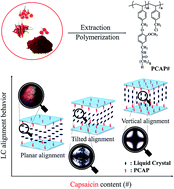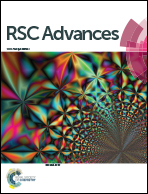Liquid crystal alignment behaviors on capsaicin substituted polystyrene films
Abstract
We synthesized a series of plant-based capsaincin substituted polystyrene (PCAP#, # = 20, 40, 60, 80, and 100), where # is the molar content of the N-vanillylnonanamide moiety as one of the capsaicin derivatives, using polymer analogous reactions to investigate their liquid crystal (LC) alignment properties. In general, the LC cell fabricated using the polymer film having a higher molar content of N-vanillylnonanamide side groups showed vertical LC alignment behavior. The vertical alignment behavior was well correlated with the surface energy of these polymer films. For example, vertical alignment was observed when the surface energy values of the polymer were smaller than about 29.26 mJ m−2 generated by the nonpolar, long carbon groups. Good electro-optical characteristics, such as voltage holding ratio (VHR) and residual DC voltage (R-DC), and aligning stabilities at 200 °C were observed for the LC cells fabricated using PCAP100 as an eco-friendly LC alignment layer based on renewable capsaicin resource containing polymer films.



 Please wait while we load your content...
Please wait while we load your content...